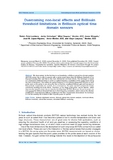Mostrar el registro sencillo del ítem
Overcoming non-local effects and Brillouin threshold limitations in Brillouin optical time domain sensors
| dc.creator | Ruiz Lombera, Rubén | es_ES |
| dc.creator | Urricelqui Polvorinos, Javier | es_ES |
| dc.creator | Sagüés García, Mikel | es_ES |
| dc.creator | Mirapeix, Jesús | es_ES |
| dc.creator | López Higuera, José Miguel | es_ES |
| dc.creator | Loayssa Lara, Alayn | es_ES |
| dc.date.accessioned | 2016-11-15T11:40:54Z | |
| dc.date.available | 2016-11-15T11:40:54Z | |
| dc.date.issued | 2015 | |
| dc.identifier.citation | R. Ruiz-Lombera, J. Urricelqui, M. Sagues, J. Mirapeix, J. M. López-Higuera and A. Loayssa, "Overcoming Nonlocal Effects and Brillouin Threshold Limitations in Brillouin Optical Time-Domain Sensors," in IEEE Photonics Journal, vol. 7, no. 6, pp. 1-9, Dec. 2015. doi: 10.1109/JPHOT.2015.2498543 | en |
| dc.identifier.issn | 1943-0655 (Print) | |
| dc.identifier.issn | 1943-0655 (Electronic) | |
| dc.identifier.uri | https://hdl.handle.net/2454/22707 | |
| dc.description.abstract | We demonstrate, for the first time to our knowledge, a Brillouin optical time domain analysis (BOTDA) sensor that is able to operate with a probe power larger than the Brillouin threshold of the deployed sensing fiber and that is free from detrimental non-local effects. The technique is based on a dual-probe-sideband setup in which an optical frequency modulation of the probe waves along the fiber is introduced. This makes the optical frequency of the Brillouin interactions induced by each probe wave on the pump to vary along the fiber so that two broadband Brillouin gain and loss spectra that perfectly compensate are created. As a consequence, the pulse spectral components remain undistorted avoiding non-local effects. Therefore, a very large probe power can be injected, which improves the signal-to-noise ratio in detection for long-range BOTDA. Moreover, the probe power can even exceed the Brillouin threshold limit due to their frequency modulation, which reduces the effective amplification of spontaneous Brillouin scattering in the fiber. Experiments demonstrate the technique in a 50-km sensing link in which 8 dBm of probe power is injected. | en |
| dc.description.sponsorship | This work was supported by the Universidad Pública de Navarra, by the Universidad de Cantabria, and by the Spanish Ministerio de Ciencia e Innovación through project TEC2013-47264-C2 and Feder funds. | en |
| dc.format.mimetype | application/pdf | en |
| dc.language.iso | eng | en |
| dc.publisher | IEEE | en |
| dc.relation.ispartof | IEEE Photonics Journal, Volume 7, Issue 6, Dec. 2015 | en |
| dc.rights | © 2015 IEEE. Personal use of this material is permitted. Permission from IEEE must be obtained for all other uses, in any current or future media, including reprinting/republishing this material for advertising or promotional purposes, creating new collective works, for resale or redistribution to servers or lists, or reuse of any copyrighted component of this work in other works. | en |
| dc.subject | Brillouin distributed sensors | en |
| dc.subject | Brillouin optical time domain analysis | en |
| dc.subject | Non-local effects | en |
| dc.subject | Brillouin threshold | en |
| dc.subject | Optical fiber sensors | en |
| dc.subject | Stimulated Brillouin scattering | en |
| dc.title | Overcoming non-local effects and Brillouin threshold limitations in Brillouin optical time domain sensors | en |
| dc.type | Artículo / Artikulua | es |
| dc.type | info:eu-repo/semantics/article | en |
| dc.contributor.department | Ingeniería Eléctrica y Electrónica | es_ES |
| dc.contributor.department | Ingeniaritza Elektrikoa eta Elektronikoa | eu |
| dc.rights.accessRights | Acceso abierto / Sarbide irekia | es |
| dc.rights.accessRights | info:eu-repo/semantics/openAccess | en |
| dc.identifier.doi | 10.1109/JPHOT.2015.2498543 | |
| dc.relation.projectID | info:eu-repo/grantAgreement/MINECO//TEC2013-47264-C2-2-R/ES/ | en |
| dc.relation.publisherversion | https://doi.org/10.1109/JPHOT.2015.2498543 | |
| dc.type.version | Versión aceptada / Onetsi den bertsioa | es |
| dc.type.version | info:eu-repo/semantics/acceptedVersion | en |
| dc.contributor.funder | Universidad Pública de Navarra / Nafarroako Unibertsitate Publikoa |





